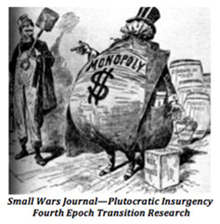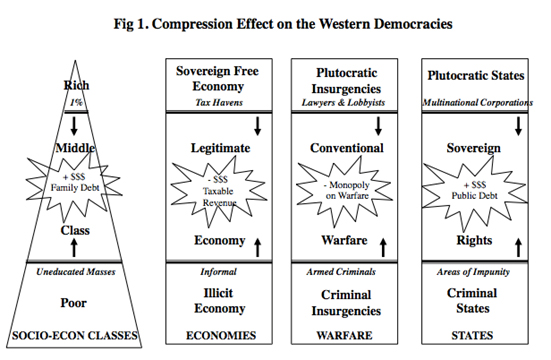Research Guide: Plutocratic Insurgency - The Gilded Age Redux
Robert J. Bunker

Plutocratic insurgency represents an emerging form of insurgency not seen since the late 19th century Gilded Age. It is being conducted by high net worth globalized elites allowing them to remove themselves from public spaces and obligations—including taxation—and to maximize their ability to generate profits transnationally. It utilizes ‘lawyers & lobbyists’ and corruption, rather than armed struggle—though mercenaries may be employed—to create shadow governance in pursuit of plutocratic policy objectives. Ultimately, this form of insurgency is representative of the challenge of 21st century predatory and sovereign-free capitalism to 20th century state moderated capitalism and its ensuing public welfare programs and middle class social structures. It can be viewed as a component of ‘Dark Globalization’ that, along with the emergence of criminal insurgency, is now actively threatening the public institutions and citizenry of the Westphalian state form.
-- Plutocratic Insurgency Notes, Small Wars Journal
This research guide has been created for Small Wars Journal readers to aid in their understanding of the plutocratic insurgency construct and explain how it is related to the earlier criminal insurgency construct which has been the focus of numerous El Centro works over the last decade. The plutocratic insurgency concept dates back to 2011 and has been influenced by earlier work done by John Robb (Onward to a Hollow State, 2008) and Nils Gilman (Deviant Globalization, 2010). As a theoretical construct, it was further inspired by the global street protests and demonstrations of the Occupy movement taking place during that period. Research on this topical area for its U.S. national security threat potentials has been conducted related to U.S. Department of Defense and Army programs, with a number of works produced or derivative of these efforts; Op-Ed: Not Your Grandfather's Insurgency (2014), Global Criminal and Sovereign Free Economies and the Demise of the Western Democracies (2014), and Old and New Insurgency Forms (2016). Of these works, the “Foreword: The twin insurgency—facing plutocrats and criminals” written by Nils Gilman for the derivative 2014 edited book project—and reprinted online as The Twin Insurgency in The American Interest—is by far the best known and eloquent of these writings:
The defining feature of the plutocratic insurgency is its goal: to defund or de-provision public goods in order to defang a state that its adherents see as a threat to their prerogatives. (Note that, conceptually, plutocratic insurgencies differ from kleptocracies; the latter use the institutions of state to loot the population, whereas the former wish to neutralize those institutions in order to facilitate private-sector looting. In practice, these may overlap or co-mingle.) Practically speaking, plutocratic insurgency takes the form of efforts to lower taxes, which necessitates cutting spending on public goods; reducing regulations that restrict corporate action or protect workers; and defunding or privatizing public institutions such as schools, health care, infrastructure, and social space.
The rise of a new plutocratic class in American society, as well as growing economic inequality in our country, and the increasing power of multinational corporations to the detriment of sovereign states have all been identified and commented upon by numerous scholars including David Rothkopf (Superclass, 2008 and Power, Inc., 2012), Chrystia Freeland (Plutocrats, 2012), David Grusky and Tamar Kricheli-Katz, eds., (The New Gilded Age, 2012), Dennis L. Gilbert (The American Class Structure in an Age of Growing Inequality, 2014), Thomas Piketty (Capital in the Twenty-First Century, 2014 and The Economics of Inequality, 2015), and Ronald Formisano (Plutocracy in America, 2015 and American Oligarchy, 2017).
Such a new class of powerful economic elites has not been witnessed since the historical Gilded Age and in some ways can be likened to the smart and talented winners of a large MonopolyTM game—one that has taken place not only within American society but also transnationally within the larger global economy that has developed. Major differences, of course, are that, unlike a traditional MonopolyTM game, this one never ends. The participants who lost do not get a restart and—since the stakes are exceedingly high, with individual and family livelihoods and futures on the line—cheating and other underhanded tricks are commonly used to ensure success. The new class of plutocrats that has emerged has moved ‘beyond the state’ and does not need or require public goods or services such as education, health services, or police protection, preferring to purchase such commodities on the open market. They seek economic impunity of action with no obligations to the state including paying taxes and, at times, even suffering the burdens of citizenship and would rather live separate (and unequal) lives to those of the common lower socio-economic members of the public.
It took the full weight of the U.S. Federal government, the muckrakers (reformist journalists), and engaged citizens to eventually tame the historical Gilded Age plutocrats. This was done over some decades through a process of trust-busting (initiated during the Roosevelt and Taft presidential administrations), newspaper exposes and shaming, anti-corruption campaigns, and ultimately robust income tax and estate tax levees to ensure that a network of aristocratic families did not come to dominate all aspects of American society. From the 1930s well into the 1970s, the plutocratic class had been relatively contained with it once again beginning to slowly emerge and then build in strength from the 1990s and beyond. This time around, however, the newly ascendant plutocratic class may not be as easy to tame, for it now exists well beyond the domestic U.S. economy and has powerful criminal confederates as allies.

The Taming of the Plutocratic Trusts by Teddy Roosevelt
Plutocratic insurgency can be placed ‘in strategic context’ when juxtaposed with John Sullivan’s criminal insurgency concept which dates back to 2008. Both concepts, in turn, draw upon Steve Metz’s brilliant postulation of the commercial insurgency form in 1993—although as a bi-furcation of that proposed form into the lower (criminal) and upper (plutocratic) socio-economic components of the burgeoning global political economy. The fusion of these two concepts—which yielded Nils Gilman’s before-mentioned twin insurgency work as a descriptive introduction to the post-modern epochal transition now taking place—provides a powerful lens into evolving elements of early 21st century dark (i.e. deviant) globalization.
A visual representation of the compression effect of the underworld of criminality pushing up into the “Goldilocks Zone” inhabited by the Western Democracies—one defined by a strong middle class, a viable legitimate (state-moderated) economy, conventional warfare, and sovereign rights—and the upper-world of sovereign free entities pushing down on it can be viewed in Figure 1. Variations on this figure have existed since 2011 and have been utilized in various briefings and presentations to diverse academic, governmental, and military and law enforcement audiences. As we increasingly enter into the epochal transition from the modern to the post-modern era, it is projected that the compression effect will become increasingly pronounced. Loss of liberal democratic leadership in the world along with a concurrent rise in non-state radicalism and state authoritarianism will progress. As the Westphalian state form perceives itself besieged, it will likely over-centralize its decision-making functions and institutional processes, exacerbating this cycle.

For the Westphalian state—and its socio-economic class structure founded on a strong, vibrant, and politically engaged middle class—the threat represented by the twin insurgencies (and sometimes collusion between these insurgent plutocrats and criminals) cannot be overstated. Contemporary state moderated capitalism has in the past functioned as a bulwark, protecting not only the middle class from predatory economic exploitation but also serving as a means to extract tax revenues from wealthy corporations and individuals (e.g. the 1%). This has been done in order to help fund state programs that provide goods and services to its citizenry and to help mitigate the economic gulf between the very rich and very poor in society thus preventing the emergence of aristocratic family dynasties which would not only threaten the integrity of the middle class but also, in the process, destroy the social mobility potentials of the underclasses.
With state moderated capitalism now increasingly becoming extinct, the economics of the Westphalian state and most of it citizenry are slowly becoming untenable. This has resulted in massive U.S. public (20 trillion USD) and household (12.7 trillion USD) debt levels, with real wealth now being concentrated at the criminal and plutocratic (as well as the hybrid autocratic) extremes where high profit levels and little-to-no sovereign taxation (other than informal bribes, kickbacks, and political contributions to co-opted officials) exist. Old adages like “What’s good for the country is good for General Motors…” and the “Horatio Alger” rags-to-riches mythos have pretty much faded away. They are being replaced with a dystopian world that looks strikingly like a Gilded Age ‘redux’ wherein the major multinational corporation shareholder families place profit over the needs of their national brethren while their scions born of a new plutocratic class enjoy rank and privilege most of society cannot imagine. Alarmingly, in American politics, no serious reform movement in the tradition of Teddy Roosevelt and other federal ‘trust busters’ has as of yet emerged from either the conservatives (Republicans), liberals (Democrats) or unaligned and opted-out center (Independents) willing to stand up to the plutocratic insurgency now in full force within our society. Rather, if the new administration’s tax cut plan is any indication, co-optation of political interests at the highest levels has now taken place, with significant tax breaks for high-income individuals and tax increases for middle class earners ensuing:
By 2027, people making $40,000 to $50,000 would pay a combined $5.3 billion more in taxes, while the group earning $1 million or more would get a $5.8 billion cut, according to the Joint Committee on Taxation and the Congressional Budget Office.
Given such a stark and disingenuous reality, the fiduciary duty of national governance for elected and appointed U.S. officials requires that some sort of federal counter-plutocratic insurgency program—enacted by governmental leaders from across the political spectrum—be established to protect the economic viability of a threatened American middle class. Failure to do so may well result in the rise of a ‘sham democracy,’ catering only to the needs of the economic elite, and the eventual fragmentation of large segments of both the middle and lower classes, that would fall even further into financial insolvency and poverty. The development of such a chilling future over the coming decades could result in increased social unrest on America’s streets that would make the relatively bloodless Occupy movement protests of 2011 seem like a walk in the park.
Plutocratic Insurgency Notes Guide
Since early 2017, a new series of research notes has been published at Small Wars Journal focusing on this topical area. These provide state-moderated capitalism scholar perspectives on the dangers of increasing wealth concentration and polarization between the ‘haves’ and ‘have nots’ not only in contemporary American society but throughout the Western liberal democracies. Present authors in this series are Robert J. Bunker, Pamela Ligouri Bunker, John P. Sullivan, and Nils Gilman with note topics including:
Note No. 1: Eight Individuals are Now as Wealthy as the Poorest Half of the World
The eight richest individuals in the world have a combined net worth of $426 billion dollars, equivalent to that of the economic bottom half of humanity—3.6 billion people. It is resulting in dystopian futures for large segments of humanity.
Note No. 2: 69% of Americans Don’t Even Have $1,000 in Savings
Google Consumer Surveys conducted by GoBankingRates.com concerning how much money respondents had in their savings accounts. In 2015, of those surveyed, 62% have less than a $1,000.00 in savings while, in 2016, this number rose to 69% of the respondents.
Note No. 3: No Shoring: Job Obsolescence Via Artificial Intelligence (AI) and Robotics
The no shoring concept—articulated by Ian Barkin (in The Wall Street Journal)—is the process of taking off-shored American jobs and bringing them back to the U.S. for artificial intelligence programs and robotic lines to perform.
Note No. 4: Silencing the Middle Class—The Gradual Extinction of Tenure in American Universities
The gradual demise of tenure and concurrent reduction in full-time faculty on American college campuses mirrors the thinning of other sectors of the middle-class workforce no longer required for 20th century based mass industrial production and conventional warfare utilizing large standing armies. Further, the gradual silencing of the middle class in U.S. public debate due to the increasing elimination of tenured faculty is a little-recognized systemic phenomenon.
Note No. 5: The Techno-Palaces of the Global Elite
Techno-palaces (e.g. the ‘needle-towers’) emerging in New York and other global financial centers provide full amenities and are guarded 24-hours by private security personnel. Units in these towers are only affordable to about 40,000 extra-sovereign individuals who can pay for the ten-million dollar-plus price in the more prestigious of these residential complexes.
Note No. 6: Privatizing Urban Public Spaces
Privately owned public spaces (Pops) are becoming key fixtures in cities around the world. This privatization of public space creates corporately controlled spaces governed by obscure private rules and policed by private security entities with minimal state control. These ‘pseudo-public spaces’ are reminiscent of feudal enclaves.
Artificial intelligence (AI) algorithms built into business applications software are increasingly changing how multinational corporations interface with their customer base. Such ‘learning software’—when combined with massive data sets tracking hundreds of individual (i.e. client specific) and group purchasing, life style, and socio-economic variables—allows for corporate profit optimization to take place by means of ‘dynamic’ and ‘algorithmic’ pricing strategies.
Much like the fictional account of the Strange Case of Dr. Jekyll and Mr. Hyde, Apple Incorporated is a beloved ‘American’ company by day when it sells its innovative and sleek technology products such as iMacs and iPhones to our citizens and those of other nations and a ‘stateless’ revenue maximizing multinational behemoth after hours when it comes time to pay the tax bill, resulting in a $250 billion cash hoard being accumulated.
Note. No. 9: Tax Cuts and Jobs Act—Class Warfare ‘Red Line’ Crossed
The prophetic plutocratic class warfare warnings of Warren Buffett (of Berkshire Hathaway fame and one of the richest persons in the United States) resound like a ‘double-tap’ to the skull of the American middle class after the recent Tax Cuts and Jobs Act has now passed in the U.S. Senate. In this bill, not only have the taxes of the rich once again been reduced but, to offset this plutocratic economic boon, the taxes of the middle class have been brazenly raised to subsidize it.
The first six of these research notes—with additional and articulate commentary—have since been rebroadcasted in two podcasts by Quintus Curtis at his Fortress of the Mind site:
The Rise Of The “Plutocratic Insurgency” (28:15 minutes)
The Continued Progress Of The Plutocratic Insurgency (26:50 minutes)
The readers of Small Wars Journal may expect to see additional plutocratic insurgency notes written in the future—in addition to more standard fare such as the ongoing criminal insurgency essays—as well as combined works which discuss the strategic level effects of the twin insurgencies as a component of the epochal transition underway.
All opinions are strictly those of the author and in no way reflect the viewpoints of any U.S. governmental, academic, or corporate entity.
About the Author(s)
Comments
Plutocratic insurgency…
Plutocratic insurgency represents an emerging form of insurgency not seen since the late 19th century Gilded Age.For other modern examples see Amazon and the Biden's. Reader 23 is a Research Guide - Gilded Age Redux https://letsgradeit.com/review/studentshare/ which Dr Bunker compares with our current environment.At others it involves a set of “interlocking criminal insurgencies where the criminal Research Guide- Plutocratic Insurgency—The Gilded Age Redux.
Quite naturally, this scares…
Quite naturally, this scares the shit out of me. Imagine if Hitler had the technology of today!
However the extent to which they still invest energy into keeping the masses in line makes me feel that their game has not been won.

